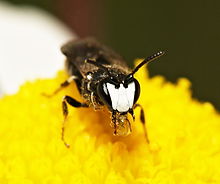| Hylaeus | |
|---|---|
 | |
| Hylaeus sp. | |
| Scientific classification | |
| Kingdom: | Animalia |
| Phylum: | Arthropoda |
| Class: | Insecta |
| Order: | Hymenoptera |
| Family: | Colletidae |
| Subfamily: | Hylaeinae |
| Genus: | Hylaeus Fabricius, 1793 |
| Subgenera | |
| many (>45) | |
Hylaeus is a large (>500 species) and diverse cosmopolitan genus within the bee family Colletidae.
Description
The genus of bees consists of generally small, black and yellow/white wasp-like species. The resemblance to wasps is enhanced by the absence of a scopa, which is atypical among bees.
Hylaeus carry pollen in the crop, rather than externally, and regurgitate it into the cell where it will be used as larval food. Like most colletids, the liquid provisions are sealed inside a membranous cellophane-like cell lining.
Nests are typically in dead twigs or plant stems, or other similarly small natural cavities, rather than constructing or excavating their own nests as in many other bees.
Distribution and status
A significant diversity of Hylaeus is found in Hawai'i — approximately sixty species are recorded as living there. Hylaeus are the only bees considered native to the islands and most of those are unique to the island chain; the diversity of this genus is far greater in Hawai'i than in all of mainland North America.[1][2] Many of them are species of concern, and some recorded there are possibly extinct. For example, H. finitimus was last collected 100 years ago, and only ever seen on the island of Kauai.[3]
The Hawaiian bee population and diversity is somewhat fluid — within the past ten to twenty years several Hylaeus species have been found and identified on the islands as new to science.[1] In October 2016, seven species were officially listed as endangered by U. S. Fish & Wildlife, the first bees to ever be placed on the endangered species list.[4][5]
Life History
Hylaeus nests in premade holes and prefers to nest in wood, but will nest in dead stems, rocks, and earthworm burrows.
Hylaeus lines their nest with a waterproof and contaminant proof with a clear cellophane substance that does not melt or dissolve with strong chemicals. They also secrete a substance that protects the nest from fungi and bacteria. This substance is secreted from the mandibles.[6]
Selected species
Species of Hylaeus include:
- Hylaeus agilis (Smith, 1876) - masked bee
- Hylaeus alcyoneus (Erichson, 1842) - Banksia bee
- Hylaeus anthracinus (Smith, 1853) – anthricinan yellow-faced bee
- Hylaeus assimulans (Perkins, 1899) – Assimulans yellow-faced bee
- Hylaeus facilis (Smith, 1879) – easy yellow-faced bee
- Hylaeus globuliferus (Cockerell, 1929)
- Hylaeus hilaris (Smith, 1879) – hilaris yellow-faced bee
- Hylaeus krombeini Snelling, 1980
- Hylaeus kuakea Magnacca & Daly, 2003 – Hawaiian yellow-faced bee
- Hylaeus longiceps (Perkins, 1899) - longhead yellow-faced bee
- Hylaeus mana Magnacca & Daly, 2003 – Hawaiian yellow-faced bee
- Hylaeus nigritus (Fabricius, 1798)
- Hylaeus punctatus (Brullé, 1832)
- Hylaeus sanguinipictus (Cockerell, 1914)
- Hylaeus sedens Snelling, 1980
- Hylaeus signatus (Panzer, 1798)
See also
- List of Hylaeus species
References
- ^ a b "Hawaii's Native Bees - Nalo Meli Maoli" (PDF). Ctahr.hawaii.edu. Retrieved 30 July 2018.
- ^ "For the First Time, Bees Declared Endangered in the U.S." 1 October 2016. Retrieved 30 July 2018.
- ^ "The Xerces Society » Yellow faced bees: Hylaeus finitimus". Xerces.org. Archived from the original on 30 July 2018. Retrieved 30 July 2018.
- ^ "Endangered and Threatened Wildlife and Plants; Endangered Status for 49 Species From the Hawaiian Islands". Federalregister.gov. 30 September 2016. Retrieved 30 July 2018.
- ^ "The Xerces Society". Xerces.org. Archived from the original on 12 February 2017. Retrieved 30 July 2018.
- ^ "INDEX", The Bees in Your Backyard, Princeton University Press, pp. 279–287, 2016-12-31, ISBN 978-1-4008-7415-6, retrieved 2021-02-04
.jpg)
